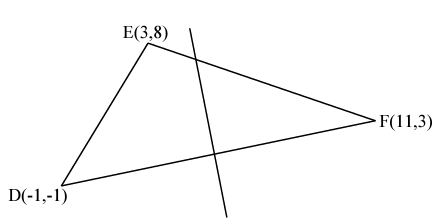FIND EQUATION OF PERPENDICULAR BISECTOR WITH TWO POINTS
A perpendicular bisector can be defined as a line segment which intersects another line perpendicularly and divides it into two equal parts.
To find equation of perpendicular bisector which connects following points (x1, y1) and (x2, y2).
(1) Find midpoint of the line segment joining the points (x1, y1) and (x2, y2). The midpoint can be named as (a, b).
(2) Find the slope of the line segment joining the points (x1, y1) and (x2, y2) and it is m.
(3) Find slope of perpendicular line -1/m.
(4) Using the point (a, b) and slope (-1/m), we find equation of perpendicular bisector.
Find the equation
of the perpendicular bisector of AB for :
Example 1 :
A(3, - 3) and B(1, - 1)
Solution :
Step 1 :
Midpoint of AB = [(x1+x2)/2, (y1+y2)/2]
A(3, - 3)------>(x1, y1)
B(1, - 1)------>(x2, y2)
Midpoint of AB = [(3+1)/2, (-3-1)/2]
Midpoint of AB = (2, - 2)
Step 2 :
Slope of the line joining the point A and B.
m = (y2–y1)/(x2–x1)
m = (-1+3)/(1–3)
m = - 2/2
m = - 1
Step 3 :
Slope of perpendicular line = -1/(-1)
= 1
Step 4 :
Equation of the perpendicular bisector of AB :
y–y1 = m(x–x1)
y+2 = 1(x–2)
y+2 = x–2
x–y
= 4
So, equation of perpendicular bisector is x-y = 4.
Example 2 :
A(1, 3) and B(- 3, 5)
Solution :
Step 1 :
A(1, 3)------>(x1, y1)
B(- 3, 5)------>(x2, y2)
Midpoint of AB = [(1-3)/2, (3+5)/2]
Midpoint of AB = (- 1, 4)
Step 2 :
Slope of the line joining the point A and B.
m = (y2 – y1)/(x2 – x1)
m = (5 - 3)/(- 3 – 1)
m = - 2/4
m = - 1/2
Step 3 :
Slope of perpendicular line = -1/(-1/2)
= 2
Step 4 :
Equation of the perpendicular bisector of AB :
y–y1 = m (x–x1)
y-4 = 2 (x+1 )
y-4 = 2x+2
2x–y+2+4 = 0
2x–y+6 = 0
So, equation of perpendicular bisector is 2x–y+6 = 0
Example 3 :
A(3, 1) and B(- 3, 6)
Solution :
Step 1 :
A(3, 1)------>(x1, y1)
B(- 3, 6)------>(x2, y2)
Midpoint of AB = [(3 - 3 )/2, (1 + 6)/2]
= [(0/2), (7/2)]
Midpoint of AB = (0, 7/2)
Step 2 :
Slope of the line joining the point A and B.
m = (y2 – y1)/(x2 – x1)
m = (6 - 1)/(- 3 – 3)
m = - 5/6
m = - 5/6
Step 3 :
Slope of perpendicular line = -1/(-5/6)
= 6/5
Step 4 :
Equation of the perpendicular bisector of AB :
y–y1 = m (x–x1)
y–7/2 = 6/5 (x–0)
(2y–7)/2 = (6/5) (x)
5(2y–7) = 12x
10y–35 = 12x
12x–10y+35 = 0
12x–10y = -35
So, equation of perpendicular bisector is 12x–10y = -35.
Example 4 :
A(4, - 2) and B(4, 4)
Solution :
Step 1 :
A(4, -
2)------>(x1, y1)
B(4, 4)------>(x2, y2)
Midpoint of AB = [(4+4)/2, (-2+4)/2]
Midpoint of AB = (4, 1)
Step 2 :
Slope of the line joining the point A and B.
m = (y2–y1)/(x2–x1)
m = (4+2)/(4–4)
m = 6/0
m = undefined
Step 3 :
Slope of perpendicular line = -1/undefined
= 0
Step 4 :
y–y1 = m (x–x1)
y - 1 = 0 (x–4)
y - 1 = 0
y = 1
So, the required equation is y = 1.
Example 5 :
A is the point (-2,-6) and B is (4,-4). Find the equation of the perpendicular bisector of the line AB

Solution :
Step 1 :
A(-2, -6)------>(x1, y1)
B(4, -2)------>(x2, y2)
Midpoint of AB = [(-2+ 4)/2, (-6-2)/2]
= (2/2, -8/2)
= (1, -4)
Midpoint of AB = (1, -4)
Step 2 :
Slope of the line joining the point A and B.
m = (y2–y1)/(x2–x1)
m = (-2-6)/(4+2)
m = -8/6
m = -4/3
Step 3 :
Slope of perpendicular line = -1/(-4/3)
= 3/4
Step 4 :
y–y1 = m (x–x1)
y - (-4) = (3/4)(x – 1)
y + 1 = (3/4)(x - 1)
4(y + 1) = 3(x - 1)
4y + 4 = 3x - 3
3x - 4y - 3 - 4 = 0
3x - 4y - 7 = 0
So, the required equation is 3x - 4y = 7
Example 6 :
A triangle DEF has vertices D(-1,-1), E(3,8) and F(11,3). Find the equation of the perpendicular bisector of the line DF.

Solution :
Midpoint of D and F, D(-1, -1) and F(11, 3)
= (-1 + 11)/2, (-1 + 3)/2
= 10/2, 2/2
= (5, 1)
Slope of the line DF :
= (3 - (-1))/(11 - (-1))
= (3 + 1) / (11 + 1)
= 4/12
= 1/3
Slope of the perpendicular bisector = -1/(1/3)
= -3
Equation of the perpendicular bisector :
y – y1 = m (x – x1)
y – 1 = -3 (x – 5)
y = -3x + 15 + 1
y = -3x + 16
So, the equation of perpendicular bisector is y = -3x + 16.
Kindly mail your feedback to v4formath@gmail.com
We always appreciate your feedback.
©All rights reserved. onlinemath4all.com
Recent Articles
-
Digital SAT Math Problems and Solutions (Part - 150)
Apr 25, 25 11:46 AM
Digital SAT Math Problems and Solutions (Part - 150) -
AP Calculus AB Problems with Solutions (Part - 19)
Apr 24, 25 11:10 PM
AP Calculus AB Problems with Solutions (Part - 19) -
AP Calculus AB Problems with Solutions (Part - 18)
Apr 24, 25 11:06 PM
AP Calculus AB Problems with Solutions (Part - 18)
